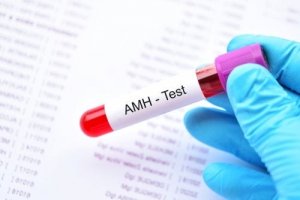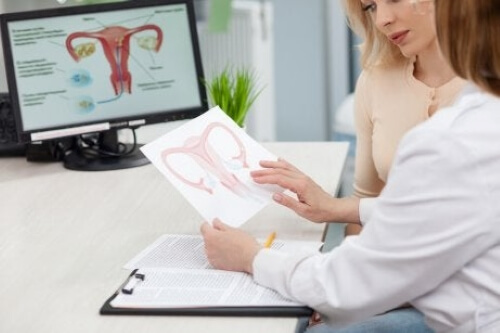What Is the Anti-Müllerian Hormone?


Written and verified by the doctor María Belén Del Río
The anti-müllerian hormone (AMH) or müllerian-inhibiting hormone is an inhibitor protein of the Müllerian ducts. This hormone suppresses the development of Müllerian ducts in male embryos. That is, it prevents male fetuses from developing the fallopian tubes, uterus, and upper vagina.
During the embryo stage, male embryos begin to express AMH via the Sertoli cells in the testicles. This begins to happen at around 7 weeks of gestation. In the female fetus, AMH isn’t detectable in the granulosa cells of the ovaries where it’s produced until about 36 weeks of gestation.
The Müllerian ducts are responsible for the morphological differences in the genitalia of boys and girls. The Müllerian ducts develop in females during the embryonic stage, and this gives rise to the uterus, fallopian tubes, cervix, and the upper 2/3 of the vagina. The early presence of AMH in male fetuses prevents this development.
Recently, doctors have discovered other ways that AMH can be an indicator of reproductive health. Researchers found that anti-müllerian hormone levels are an indicator of the quality of ovarian reserve in women. This is useful in assisted reproduction efforts and in predicting the onset of menopause.
What information can the anti-müllerian hormone provide?
For many years, doctors understood this hormone to be tied to fetal sex development. But just recently, doctors have discovered that it’s also a useful marker of ovarian function.
The anti-müllerian hormone has specific applications in gynecological medicine, like the following:
- It aids in the regulation of follicle growth
- It influences the production of testosterone

The secretion of the anti-müllerian hormone reflects the activity of the antral and preantral follicles. Therefore, it’s a good marker that doctors can use to assess the ovarian reserve.
As a woman’s age increases, the ovarian follicles and the quality of the ovum diminish. Various studies show that AMH values and the values of other hormones also diminish over the female’s reproductive lifespan.
When ovarian follicles grow they produce AMH. AMH has two main actions in the ovary: it inhibits the initial recruitment of primary follicles from primordial follicles. Likewise, it makes the antral follicles less sensitive to follicle-stimulating hormone (FSH). Thus, AMH prevents the premature depletion of follicles.
When AMH levels begin to diminish then follicles will deplete more rapidly and there is less in terms of ovarian reserve. This is why AMH levels can help discern the age at which a woman will likely begin to experience menopause.
AMH levels and menopause
Thus, the measurement of AMH levels in the blood can predict when she is likely to begin menopause. The concentrations of AMH in the blood show a close relationship with the follicular reserve and reproductive capacity. Far more than the measurement of other hormones like follicle-stimulating hormones or estrogen.
Furthermore, AMH can be useful as a tool for diagnosing and discovering the causes of:
- Polycystic ovary syndrome
- Secondary amenorrhea
- Early ovarian failure
- Other dysfunctions of the hypothalamus-pituitary axis
In addition, measuring AMH levels in the blood also allows doctors to study certain ovarian tumors and their effects on the granulosa cells.
The anti-müllerian hormone and assisted reproduction techniques
Today there are many professionals who consider it important to evaluate the ovarian reserve before beginning any assisted reproduction techniques, especially before in vitro fertilization (IVF).
The study of the ovarian reserve permits identification of women who are hyper- or hypo-responsive to ovarian stimulation; AMH is a good predictor of ovarian response to ovarian hyperstimulation, which is an important part of undergoing IVF treatments where there is ovulation induction using injectables like clomiphene. Knowing the AMH levels helps doctors to predict the risk for ovarian hyperstimulation syndrome.

Although this hormone is more useful for the study of feminine infertility, it isn’t a marker that can predict fertilization or pregnancy, nor does it tell us about oocyte or embryo quality.
Regarding AMH remember…
Although we’ve known about the existence of this hormone for many years, its utility in understanding the ovarian reserve has only been discovered recently.
There are a number of advantages to studying AMH compared to the other hormones or endocrinological markers used to date. It has a wide range of clinical applications in understanding ovarian health and function.
In conclusion, at the present time, a large number of women are undergoing assisted reproduction treatments, where the role of the anti-müllerian hormone is of great relevance. AMH is now a valuable tool in the management of female infertility.
The anti-müllerian hormone (AMH) or müllerian-inhibiting hormone is an inhibitor protein of the Müllerian ducts. This hormone suppresses the development of Müllerian ducts in male embryos. That is, it prevents male fetuses from developing the fallopian tubes, uterus, and upper vagina.
During the embryo stage, male embryos begin to express AMH via the Sertoli cells in the testicles. This begins to happen at around 7 weeks of gestation. In the female fetus, AMH isn’t detectable in the granulosa cells of the ovaries where it’s produced until about 36 weeks of gestation.
The Müllerian ducts are responsible for the morphological differences in the genitalia of boys and girls. The Müllerian ducts develop in females during the embryonic stage, and this gives rise to the uterus, fallopian tubes, cervix, and the upper 2/3 of the vagina. The early presence of AMH in male fetuses prevents this development.
Recently, doctors have discovered other ways that AMH can be an indicator of reproductive health. Researchers found that anti-müllerian hormone levels are an indicator of the quality of ovarian reserve in women. This is useful in assisted reproduction efforts and in predicting the onset of menopause.
What information can the anti-müllerian hormone provide?
For many years, doctors understood this hormone to be tied to fetal sex development. But just recently, doctors have discovered that it’s also a useful marker of ovarian function.
The anti-müllerian hormone has specific applications in gynecological medicine, like the following:
- It aids in the regulation of follicle growth
- It influences the production of testosterone

The secretion of the anti-müllerian hormone reflects the activity of the antral and preantral follicles. Therefore, it’s a good marker that doctors can use to assess the ovarian reserve.
As a woman’s age increases, the ovarian follicles and the quality of the ovum diminish. Various studies show that AMH values and the values of other hormones also diminish over the female’s reproductive lifespan.
When ovarian follicles grow they produce AMH. AMH has two main actions in the ovary: it inhibits the initial recruitment of primary follicles from primordial follicles. Likewise, it makes the antral follicles less sensitive to follicle-stimulating hormone (FSH). Thus, AMH prevents the premature depletion of follicles.
When AMH levels begin to diminish then follicles will deplete more rapidly and there is less in terms of ovarian reserve. This is why AMH levels can help discern the age at which a woman will likely begin to experience menopause.
AMH levels and menopause
Thus, the measurement of AMH levels in the blood can predict when she is likely to begin menopause. The concentrations of AMH in the blood show a close relationship with the follicular reserve and reproductive capacity. Far more than the measurement of other hormones like follicle-stimulating hormones or estrogen.
Furthermore, AMH can be useful as a tool for diagnosing and discovering the causes of:
- Polycystic ovary syndrome
- Secondary amenorrhea
- Early ovarian failure
- Other dysfunctions of the hypothalamus-pituitary axis
In addition, measuring AMH levels in the blood also allows doctors to study certain ovarian tumors and their effects on the granulosa cells.
The anti-müllerian hormone and assisted reproduction techniques
Today there are many professionals who consider it important to evaluate the ovarian reserve before beginning any assisted reproduction techniques, especially before in vitro fertilization (IVF).
The study of the ovarian reserve permits identification of women who are hyper- or hypo-responsive to ovarian stimulation; AMH is a good predictor of ovarian response to ovarian hyperstimulation, which is an important part of undergoing IVF treatments where there is ovulation induction using injectables like clomiphene. Knowing the AMH levels helps doctors to predict the risk for ovarian hyperstimulation syndrome.

Although this hormone is more useful for the study of feminine infertility, it isn’t a marker that can predict fertilization or pregnancy, nor does it tell us about oocyte or embryo quality.
Regarding AMH remember…
Although we’ve known about the existence of this hormone for many years, its utility in understanding the ovarian reserve has only been discovered recently.
There are a number of advantages to studying AMH compared to the other hormones or endocrinological markers used to date. It has a wide range of clinical applications in understanding ovarian health and function.
In conclusion, at the present time, a large number of women are undergoing assisted reproduction treatments, where the role of the anti-müllerian hormone is of great relevance. AMH is now a valuable tool in the management of female infertility.
All cited sources were thoroughly reviewed by our team to ensure their quality, reliability, currency, and validity. The bibliography of this article was considered reliable and of academic or scientific accuracy.
- Capecce, E., Pelanda, M., Dicugno, M., De Sampaio, E. G., Buongiorno, G., Corazza, N., … Ruibal, G. (2016). La hormona antimülleriana como marcador de función ovárica. Revista Argentina de Endocrinologia y Metabolismo. https://doi.org/10.1016/j.raem.2016.06.003
- Medina S Cristián, Aguirre F Javiera, Montecinos G Jimena, Schiappacasse F Giancarlo. (2015). Revisión pictográfica de las anomalías de los conductos de Müller por resonancia magnética. Rev. chil. obstet. ginecol. 80( 2 ): 181-190.
- Morales, H. S. G., Ulloa-Aguirre, A., Martínez, J. C. F., Martínez, E. E. M., López, R. R., & García-Lascurain, L. C. (2012). Hormona antimulleriana como marcador de respuesta ovárica en fertilización in vitro. Ginecologia y Obstetricia de Mexico.
- Unger, S., & Pizzoglio, H. B. (2010). Premios Biología-Curso SAMeR Hormona antimülleriana. Reserva ovárica y reserva testicular • Introducción. Reproducción.
This text is provided for informational purposes only and does not replace consultation with a professional. If in doubt, consult your specialist.








